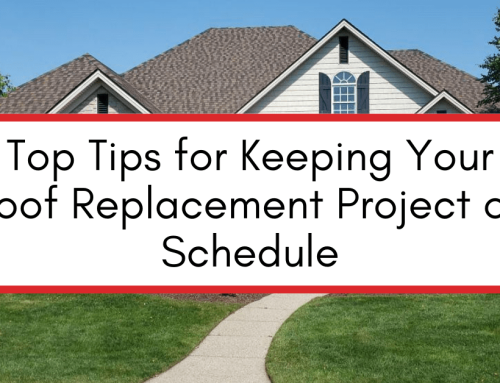Replacing a residential roof is a major undertaking that requires careful planning and execution. Your roofing contractor should fully communicate the roof replacement timeline before they begin work. Proper communication is one of the many reasons why choosing a trustworthy roofing contractor is so important.
In this article, we will take you through the complete timeline of a residential roof replacement, discussing each step in detail. It’s important to understand the timeline (and to clarify this with your contractor before they begin!) so you can ensure a smooth process.
Preparing for Roof Replacement
Replacing a roof is a significant investment that requires careful planning and decision-making. It is not a task to be taken lightly, as it directly impacts the safety, functionality, aesthetics and value of your home. Before diving into the roof replacement process, there are a few crucial considerations to keep in mind.
Choosing the Right Roofing Material
Selecting the right roofing material is vital for the longevity and aesthetics of your new roof. With a wide range of options available, it can be overwhelming to make a decision. However, taking the time to research and understand the pros and cons of each material will help you make an informed choice.
The most popular roofing material is asphalt shingles. They are affordable, easy to install, and come in a variety of colors and styles. Asphalt shingles are also durable and can withstand harsh weather conditions. However, they may not be as long-lasting as other materials.
Another option to consider is metal roofing. Metal roofs are known for their durability and longevity. They can last up to 50 years or more and require minimal maintenance. Metal roofs are also energy-efficient and environmentally friendly. However, they can be more expensive upfront.
Hiring a Professional Roofing Contractor
While a DIY approach may be tempting, replacing a roof is a complex task that requires professional expertise. Hiring a reputable roofing contractor is crucial to ensure a successful and hassle-free project.
When searching for a roofing contractor, it is essential to do thorough research. Seek recommendations from friends, family, or neighbors who have recently had their roofs replaced. Look for contractors who have positive reviews, a good track record, and a solid reputation in the industry.
A reputable contractor will have proper licensing and insurance, ensuring that you are protected in case of any accidents or damages during the project.
Be sure to get bids from at least 2-3 different roofing contractors. This will give you a better understanding of the average cost of the project and help you compare different contractors’ pricing and services. Remember that the cheapest option may not always be the best, so consider the contractor’s experience, expertise, warranty and reputation along with the cost.
By hiring a professional roofing contractor, you can have peace of mind knowing that your roof replacement project is in capable hands. They will have the necessary skills, knowledge, and equipment to complete the job efficiently and to a high standard.
The Roof Replacement Process
Now that you’re fully prepared, let’s delve into the actual roof replacement process:
- Initial Inspection and Estimate
First, you’ll need to set up an appointment with a trusted contractor. They will conduct a thorough inspection of your existing roof. This inspection allows them to assess the extent of the damage and provide you with an estimate that outlines the scope of the project, including materials and labor costs.
During the initial inspection, the roofing contractor will carefully examine every aspect of your roof. They will check for any signs of damage, such as missing or damaged shingles, leaks, or structural issues. The contractor will also inspect the attic to assess the condition of the roof deck and insulation.
After the inspection, the contractor will provide you with a detailed estimate. This estimate will include the cost of materials, such as shingles, underlayment, and flashing, as well as the cost of labor. The estimate will also outline the timeline for the project, giving you an idea of how long the roof replacement process will take.
- Removing the Old Roof
The next step involves the removal of the old roof. The roofing crew will carefully strip away the existing shingles, ensuring that all debris is properly disposed of.
Removing the old roof is a meticulous process that requires attention to detail. The roofing crew will use specialized tools to carefully pry up the shingles, being careful not to damage the underlying structure. They will also remove any nails or staples that were used to secure the old shingles.
Once the old shingles are removed, the crew will inspect the roof deck for any signs of damage. If any repairs are needed, they will be addressed before proceeding with the installation of the new roof.
- Installing the New Roof
Once the old roof is removed, the contractors will proceed with installing the new roof. This includes adding underlayment, flashing, and finally, the selected roofing material. The installation process varies depending on the chosen material and the complexity of your roof’s design.
The first step in installing the new roof is to add the underlayment. This is a protective layer that is placed directly on the roof deck. It helps to prevent water from seeping into the roof and provides an additional layer of insulation.
After the underlayment is installed, the contractors will then install the flashing. Flashing is a material that is used to seal joints and prevent water from entering the roof. It is typically installed around chimneys, vents, and other areas where the roof meets a vertical surface.
Finally, the roofing crew will install the selected roofing material. This could be asphalt shingles, metal roofing, or any other material that you have chosen. The installation process will vary depending on the type of material, but the crew will ensure that it is installed correctly and securely.
Throughout the installation process, the roofing crew will take measures to protect your property. They will use tarps and other protective coverings to prevent damage to your landscaping, windows, and other areas of your home.
Post Roof Replacement Considerations
Once your new roof is in place, there are a few additional considerations to keep in mind:
- Cleaning Up After Installation
Roof replacement projects often generate a significant amount of debris. Ensure that your roofing contractor cleans up properly, disposing of old shingles, nails, and any other waste. This will help protect your property and keep the surroundings clean.
- Roof Maintenance Tips
Regular maintenance is key to prolonging the lifespan of your new roof. Schedule annual inspections, clear debris from gutters regularly, and promptly address any issues that arise.
Frequently Asked Questions about Roof Replacement
Here are answers to some common questions homeowners have when considering a roof replacement:
Question: How Long Does Roof Replacement Take?
Answer: The duration of a roof replacement depends on various factors, such as the size of the roof, the complexity of the project, and weather conditions. On average, it can take anywhere from a few days to a couple of weeks. Most roof replacements done by AIC Roofing & Construction only take 1 day to complete!
Question: What is the Cost of Roof Replacement?
Answer: The cost of a roof replacement varies significantly based on factors like the size of the roof, the chosen roofing material, and additional elements such as insulation or skylights. It’s best to obtain estimates from multiple contractors to get an accurate idea of the potential costs. If you live in the Central Kentucky area and want a generic estimate, check out our Instant Quote feature. It will provide you with a ballpark estimate for your roof replacement cost.
Question: Can I Live in My House During Roof Replacement?
Answer: In most cases, it is possible to live in your house during roof replacement. However, keep in mind that the process can be noisy and disruptive. It’s important to discuss this with your contractor beforehand and make appropriate accommodations if necessary.
Wrapping Up
By following this complete residential roof replacement timeline, you can navigate the process with confidence. Understand the signs of roof damage, prepare for the project, and consider post-replacement maintenance. With the help of a professional roofing contractor, your new roof will be installed efficiently, ensuring a safe and secure home for years to come.
AIC Roofing and Construction has served homeowners in Louisville, Lexington, Richmond and Cincinnati since 2003. We are in the top 2% of roofing contractors in North America to obtain the GAF MasterElite certification – something we renew every year as part of our commitment to excellence. If you’re looking for a top-rated Central Kentucky roofing company – we’d love to see if we would be a good fit for your project. Contact us today to schedule your free roof inspection.
3-tab attics barns chimney choosing a contractor commercial cost curb appeal DIY estimate financing flashing flat roof GAF glossary gutter replacement gutters gutter size gutter system ice dams inspections insurance missing shingles roof design roofing materials roofing system roof leak roof maintenance roof materials roof repair roof replacement roof shapes roof types shingle ratings shingles siding siding materials siding replacement skylights storm damage underlayment ventilation warranty winter







